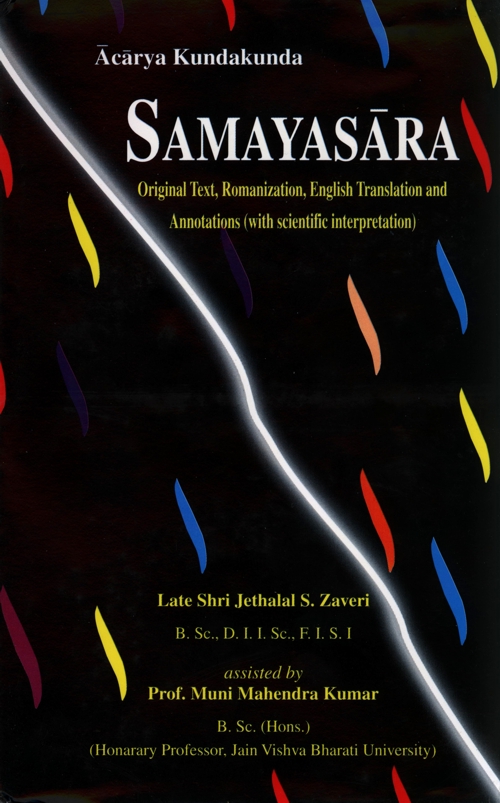Soul And Karma Serve Each Other As External Cause Of Modification

jῑvapariṇāmaheduṃ kammattaṃ poggalā pariṇamaṃtῑ.
poggalakammaṇimittaṃ taheva jῑvo vi pariṇamadi.. 12

ṇa vi kuvvadi kammaguṇe jῑvo kammaṃ taheva jῑvaguṇe.
aṇṇoṇṇaṇimitteṇa du pariṇāmaṃ jāṇā doṇhaṃ pi.. 13

edeṇa kārṇeṇa du kattā ādā sageṇa bhāveṇa.
poggalakammakadāṇaṃ ṇa du kattā savvabhāvāṇaṃ.. 14
(Jῑvapariṇāmaheduṃ) The psychic changes serve as the external cause for (poggalā kammattaṃ pariṇamaṃti) mutation of the karmic matter into karma, (taheva) in the same way (poggalakammaṇimittaṃ) change in the material karma (jῑvovi pariṇamadi) serves as external cause for psychic mutation (such as anger, attachment).
(Jῑvo) The soul (kammaguṇe ṇa vi kuvvadi) cannot produce attributes of karma, (taheva) in the same way (kammaṃ jῑvaguṇe) karma cannot produce psychic attributes of the jῑva; (du) however, (aṇṇoṇṇaṇimitteṇa doṇhaṃ pi pariṇāmaṃ jāṇa) know that both serve each other as external causes for mutation.
(Edeṇa kāraṇeṇa du) That is why (ādā) the soul (kattā sageṇa bhāveṇa) is the producer only of its own attributes (du) but (poggalakammakadāṇaṃ ṇa kattā savvabhāvāṇaṃ) is not the producer of all mutations of material karma.
Annotations:
In these verses Ācārya Kundakunda proceeds with the discussion of psycho-physical relationship which was initiated in the preceding ones. The key word in these verses, which lays the foundation of the Jain theory of psycho-physical relations, is the external or auxiliary cause (nimitta kāraṇa). The author makes use of the distinction between the two causal agencies or conditions necessary for mutation or change: (i) Substantial or intrinsic cause (upādānakāraṇa) (ii) external or auxiliary cause (nimitta kāraṇa).
Both soul and karmic matter have to undergo change because both are subject to mutation (pariṇāma) according to the Jain mutation view. To bring about a change, however, two types of causal agencies are needed as stated above, now, soul and karma are two different substances, and each of them is capable of being the substantial cause only of its own modes/mutation but not of the other. But their extremely close proximity (in an organism) with each other makes them serve each other as an external cause (nimitta kāraṇa). Thus the position of their relationship may be stated somewhat like this: In an organism a series of changes occur in the karma śarῑra succeeding one another (in accord with the laws of the doctrine of karma) and every change is determined by a karmic antecedent. Simultaneously a series of psychic changes also occur in the soul (controlled by the same doctrine) and every change is determined by a psychic antecedent. Now in these occurrences, the psychic nature of the soul itself is the direct and immediate cause of the series of the psychic states, such as attachment, anger, etc., but the external cause of these states is the states (such as fruition etc.) of karma with which it is associated. The karma referred to here is dravya karma or karma-śarῑra which is distinctly material and not bhāva karma. Dravya karma, as we know, is composed of material atoms of karma-vargaṇā, the subtlemost group of matter. This group has a special affinity for clinging to the soul and a soul, in worldly state, is always associated with it. The gist of the above verses is that psychic modes and states of karma mutually determine each other, i.e., a change in karma may bring about a corresponding psychic change which generally has a predominant affective tone and manifests itself as an emotion or passion in the organism. This emotional psychic state is bhāva karma. Since it is a psychic event its substantial cause (upādāna kāraṇa) is the soul itself and not karma. Stated differently, a change in dravya karma acts as an external causal agent and brings about a change in bhāva karma i.e., corresponding change in the purity of the soul. The bhāva karma, in its turn, will produce an emotional filling in the form of a psychological distortion. Thus the chain of causation can be diagrammatically represented thus
Dravya Karma (Karmic matter)
↓
Bhāva Karma (Psychic impurity)
↓
Emotion (or feeling) - Psychological distortion
Thus a psychological distortion (anger, hate, fear) emerges as the effect of two causal agents: bhāva karma (substantial cause) and dravya karma (external or auxiliary cause). In the succeeding verses the psycho-physical theory is examined from different aspects.
 Jethalal S. Zaveri
Jethalal S. Zaveri
 Prof. Muni Mahendra Kumar
Prof. Muni Mahendra Kumar

